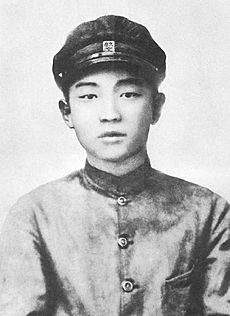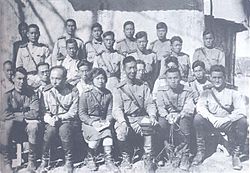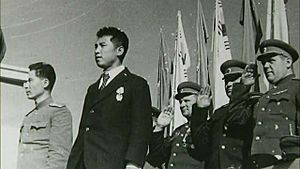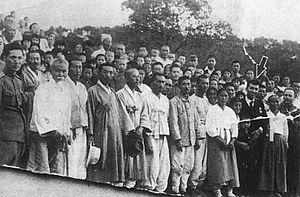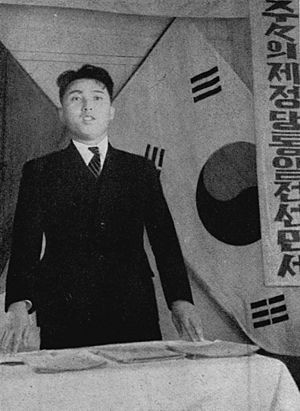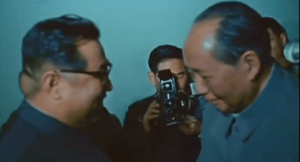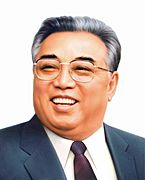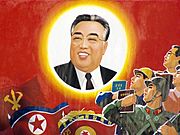Kim Il-sung facts for kids
Quick facts for kids
Eternal President
Kim Il-sung
|
|
|---|---|
|
김일성
|
|
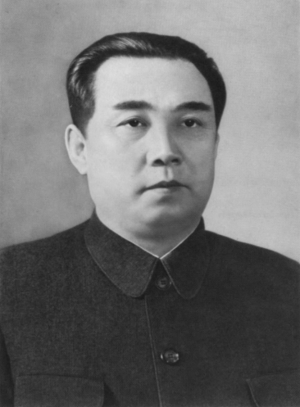
Kim c. 1960s
|
|
| General Secretary of the Workers' Party of Korea | |
| In office 12 October 1966 – 8 July 1994 |
|
| Secretary |
See list
Choe Yong-gon
Kim Il Pak Kum-chol Ri Hyo-son Kim Kwang-hyop Sok San Ho Pong-hak Kim Yong-ju Pak Yong-guk Kim To-man Ri Kuk-jin Kim Jung-rin Yang Hyong-sop O Jin-u Kim Tong-gyu Han Ik-su Hyon Mu-gwang Kim Jong-il Hwang Jang-yop Kim Yong-nam Kim Hwan Yon Hyong-muk Yun Ki-bok Hong Si-hak |
| Preceded by | Himself (as Chairman) |
| Succeeded by | Kim Jong-il |
| President of North Korea | |
| In office 28 December 1972 – 8 July 1994 |
|
| Premier |
See list
|
| Vice President |
See list
Choe Yong-gon
Kang Ryang-uk Kim Tong-kyu Kim Il Pak Song-chol Rim Chun-chu Ri Jong-ok Kim Pyong-sik |
| Preceded by | Office established |
| Succeeded by | Office abolished |
| Chairman of the Workers' Party of Korea | |
| In office 24 June 1949 – 12 October 1966 |
|
| Vice Chairman |
See list
Ho Ka-i
Pak Hon-yong Kim Il Pak Chang-ok Pak Chong-ae Pak Kum-chol Pak Yong-bin Choe Yong-gon Jong Il-yong Kim Chang-man Ri Hyo-son |
| Preceded by | Kim Tu-bong |
| Succeeded by | Himself (as General Secretary) |
| Premier of North Korea | |
| In office 9 September 1948 – 28 December 1972 |
|
| First Vice Premier | Kim Il |
| Vice Premier |
See list
Pak Hon-yong
Hong Myong-hui Kim Chaek Kim Il Jong Il-ryong Nam Il Pak Ui-wan Jong Jun-thaek Kim Kwang-hyop Kim Chang-man Ri Jong-ok Ri Ju-yon Pak Song-chol Choe Yong-jin |
| Preceded by | Office established |
| Succeeded by | Kim Il |
| Supreme Commander of the Korean People's Army |
|
| In office 5 July 1950 – 24 December 1991 |
|
| Preceded by | Choe Yong-gon |
| Succeeded by | Kim Jong-il |
| Personal details | |
| Born |
Kim Song-ju
15 April 1912 Namni, South Heian Province, Korea (present-day Mangyongdae, Pyongyang, North Korea) |
| Died | 8 July 1994 (aged 82) Hyangsan Residence, Hyangsan County, North Pyongan Province, North Korea
|
| Resting place |
Kumsusan Palace of the Sun, Pyongyang
|
| Political party | Workers' Party of Korea |
| Other political affiliations |
Workers' Party of North Korea (1946–1949) Chinese Communist Party (1931–1946) |
| Spouses |
|
| Children |
|
| Parents | Kim Hyong-jik Kang Pan-sok |
| Relatives | Kim family |
| Residences | Pyongyang, North Korea |
| Profession | Politician |
| Signature | |
| Military service | |
| Allegiance |
|
| Branch/service | |
| Years of service |
|
| Rank | Taewonsu |
| Unit | 88th Separate Rifle Brigade, Red Army |
| Commands | All (Supreme Commander) |
| Battles/wars | |
| Korean name | |
| Chosŏn'gŭl | |
| Hancha | |
| Revised Romanization | Gim Il(-)seong |
| McCune–Reischauer | Kim Ilsŏng |
| Birth name | |
| Chosŏn'gŭl | |
| Hancha | |
| Revised Romanization | Gim Seong(-)ju |
| McCune–Reischauer | Kim Sŏngchu |
|
Central institution membership
1980–1994: Member, Presidium of the Political Bureau of the 6th Central Committee of the Workers' Party of Korea
1970–1980: Member, Political Committee of the Central Committee of the Workers' Party of Korea 1966–1994: Secretariat of the Workers' Party of Korea 1966–1970: Member, Standing Committee of the Political Committee of the Central Committee of the Workers' Party of Korea 1961–1970: Chairman, Political Committee of the Central Committee of the Workers' Party of Korea 1956–1961: Member, Standing Committee of the Central Committee of the Workers' Party of Korea 1948–1994: Deputy, 1st, 2nd, 3rd, 4th, 5th, 6th, 7th, 8th and 9th Supreme People's Assembly 1946–1956: Member, Political Committee of the Central Committee of the Workers' Party of Korea 1946–1994: Member, 1st, 2nd, 3rd, 4th, 5th, and 6th Central Committee of the Workers' Party of Korea Other offices held
1982–1994: Chairman, Central Military Commission of the Workers' Party of Korea
1972–1992: Chairman, National Defense Commission of the Central People's Committee of the Democratic People's Republic of Korea 1970–1982: Chairman, Military Commission of the Central Committee of the Workers' Party of Korea 1992–1993: Chairman, National Defense Commission of the Democratic People's Republic of Korea 1947–1948: Chairman, People's Committee of North Korea 1946–1949: Vice Chairman, Central Committee of the Workers' Party of North Korea 1946–1947: Chairman, Provisional People's Committee of North Korea 1945–1946: Chairman, North Korea Bureau of the Communist Party of Korea Republic of Korea
|
|
Kim Il-sung (born Kim Song-ju, 15 April 1912 – 8 July 1994) was a Korean politician. He founded North Korea and ruled it from 1948 until his death in 1994. He was the country's Premier from 1948 to 1972 and President from 1972 to 1994. He also led the Workers' Party of Korea (WPK) from 1949 to 1994.
After Japan's rule ended in 1945, Kim Il-sung came to power. In 1950, he ordered the invasion of South Korea. This started the Korean War, which involved the United Nations and the United States. A ceasefire was signed in 1953. Kim Il-sung was one of the longest-serving non-royal leaders in the 20th century.
Under Kim Il-sung, North Korea became a socialist state. Its economy was centrally planned, meaning the government controlled everything. North Korea had strong ties with the Soviet Union. For a time, North Korea had a better standard of living than South Korea. However, by the 1980s, South Korea's economy grew strong, while North Korea's economy struggled.
Kim Il-sung developed a philosophy called Juche. This idea focused on Korean nationalism, self-reliance, and socialism. North Korea received aid from the Soviet Union until it broke apart in 1991. This loss of aid led to a severe famine in 1994. Kim Il-sung was known as the "Great Leader" (Suryong). He created a strong personality cult around himself. This means people were taught to admire and worship him greatly.
In 1980, his oldest son, Kim Jong-il, was chosen to be his successor. Kim Il-sung's birthday, April 15, is a national holiday in North Korea called the "Day of the Sun". In 1998, after his death, Kim Il-sung was named "eternal President of the Republic".
Contents
Kim Il-sung's Early Life
Family and Childhood
Kim Il-sung was born Kim Song-ju on April 15, 1912. His parents were Kim Hyong-jik and Kang Pan-sok. He had two younger brothers. His family came from Jeonju, but his great-grandfather settled near Pyongyang in 1860. Kim was reportedly born in a small village called Mangyungbong.
Kim said his family was not poor, but they were always close to it. He grew up in a Presbyterian family. His maternal grandfather was a minister, and his father was active in the church. North Korean accounts say Kim's family was involved in anti-Japanese activities. In 1920, they moved to Manchuria. Many Korean families fled there because Japan ruled Korea harshly.
Joining the Communist Movement
In 1926, Kim founded the "Down-with-Imperialism Union." He attended military school but left in 1927. He then went to Yuwen Middle School in China until 1930. There, he became interested in communist ideas. Police arrested him for his activities and he was jailed for several months.
In 1931, Kim joined the Chinese Communist Party. He joined guerrilla groups fighting against the Japanese in northern China. In 1935, Kim became part of the Northeast Anti-Japanese United Army. This was a guerrilla group led by the Chinese Communist Party. Kim became a political leader for a group of about 160 soldiers.
Kim's leadership grew stronger during a difficult time called the Minsaengdan incident. Chinese communists suspected some Koreans were secretly working for Japan. Many Koreans were removed from the Communist Party. Kim was arrested but later cleared. He gained trust by destroying suspicious files, showing compassion.
In 1935, Kim took the name Kim Il-sung, which means "Kim become the sun". In 1937, at age 24, he became commander of a division of a few hundred men. On June 4, 1937, he led 200 guerrillas in a raid on Poch'onbo. They destroyed government offices and set fire to a Japanese police station. This raid showed Kim's skill as a military leader. The Japanese saw Kim as a very effective guerrilla leader. They called him the "Tiger".
In 1940, Kim and his remaining army escaped into the Soviet Union. The Soviets trained Korean communist guerrillas at a camp near Khabarovsk. In 1942, Kim and his army joined the 88th Separate Rifle Brigade. This was a special unit of the Soviet Red Army. Kim became a Major in the Soviet Red Army and served until World War II ended in 1945.
Returning to Korea
The Soviet Union declared war on Japan in August 1945. The Red Army entered Pyongyang on August 24, 1945. Soviet leaders chose Kim to lead the Soviet-controlled areas.
Kim arrived in Korea on September 19, 1945, after 26 years away. Some sources say his Korean language skills were not very good. He needed help to read a speech at a Communist Party meeting.
In December 1945, the Soviets made Kim the First Secretary of the Korean Communist Party's North Korean branch. He became the top Korean leader in the North.
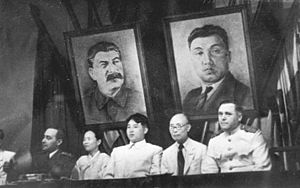
To strengthen his power, Kim created the Korean People's Army (KPA). He recruited guerrillas and soldiers who had fought against the Japanese. With Soviet help, Kim built a strong army. Before the Korean War, the Soviet Union provided the KPA with modern tanks and weapons.
Doubts about Kim Il-sung's Identity
Some people have claimed that the name "Kim Il-sung" was used by another Korean resistance leader before him. A Soviet officer said Kim took the name from a dead commander. However, many historians disagree with this idea. They say that witnesses knew Kim before and after his time in the Soviet Union. Japanese officers also confirmed his fame as a resistance fighter.
Historians generally agree that Kim was an important guerrilla leader. Even though his achievements were greatly exaggerated by the personality cult built around him, he was a real and significant figure.
Kim Il-sung as Leader of North Korea
Early Years of Rule

In August 1948, the Soviets held elections in their zone for a Supreme People's Assembly. The Democratic People's Republic of Korea (North Korea) was created on September 9, 1948, with Kim as its premier. On August 15, 1948, South Korea had also declared itself a state.
The Communist Party in North Korea merged with another party to form the Workers' Party of North Korea. Kim became its vice-chairman. In 1949, this party merged with its southern counterpart to become the Workers' Party of Korea (WPK), with Kim as its chairman. By 1949, Kim and the communists had firm control of North Korea. Around this time, Kim began to promote a strong personality cult. Statues of him appeared, and he started calling himself "Great Leader".
In February 1946, Kim Il-sung introduced several reforms. Over half of the farming land was given to peasants. An 8-hour workday was set, and all major industries became government-owned. Healthcare was also made free for all citizens.
The Korean War

Historical documents show that Kim Il-sung decided to invade South Korea. He believed the United States would not get involved. China agreed to the invasion after Kim said the Soviet leader, Joseph Stalin, had approved it. China did not send direct military help until later in the war.
In June and July 1950, North Korean forces captured Seoul and most of South Korea. However, in September, a counterattack led by the US and UN forces pushed the North Koreans back. By October, UN forces had retaken Seoul and invaded North Korea. Kim and his government had to flee north.
On October 25, 1950, Chinese troops entered the war to help North Korea. UN troops were forced to retreat. Chinese troops retook Pyongyang in December and Seoul in January 1951. The fighting continued with many attacks and counterattacks. The front line eventually settled near the 38th Parallel in July 1953. A ceasefire was signed, ending the fighting. Over 2.5 million people died during the Korean War.
Documents from that time show Kim wanted a truce. He realized that unifying Korea under his rule was unlikely with the UN and US forces present. He also felt that the Chinese were taking over too much of the fighting.
Strengthening His Power
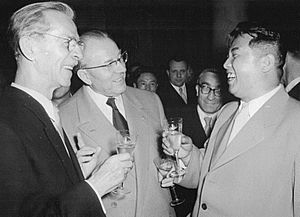
After the Korean War, North Korea was badly damaged. Kim Il-sung started a big effort to rebuild the country. He launched a five-year economic plan. This plan created a command economy, where the government controlled all industry and farming. The economy focused on heavy industry and making weapons. By the 1960s, North Korea briefly had a higher standard of living than South Korea.
Kim also became an independent leader in the global communist movement. In 1956, he disagreed with the Soviet Union's new policies. He also strengthened his power over the Korean communist movement. Rival leaders were removed. Kim developed the idea of Juche, which emphasized Korean independence and self-reliance.
During his rule, Kim created the songbun caste system. This system divided North Koreans into three groups based on their family background. This classification affected everything in a person's life. It decided access to education, housing, jobs, and food. Many people from the "hostile" class, like intellectuals and landowners, were forced to move to isolated northern areas. When a famine hit in the 1990s, these people suffered the most.
Kim Il-sung's government was responsible for serious human rights issues. He punished people who disagreed with him. Those who were seen as disloyal, and sometimes their families, were sent to special camps. These camps, called kwanliso, were in mountainous areas. Prisoners were forced to do very hard labor in harsh conditions.
Later Years of Rule
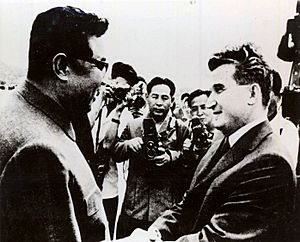
Kim Il-sung kept good relations with the Soviet Union. He also reconnected with most communist countries in Eastern Europe. He was especially close with East Germany and Romania. Romania's leader, Nicolae Ceaușescu, was greatly influenced by Kim's leadership style.
In the 1960s, Kim was impressed by North Vietnam's efforts to unify Vietnam through guerrilla warfare. He thought North Korea could do something similar. North Korea increased its efforts to infiltrate South Korea. This led to conflicts along the Korean Demilitarized Zone. The capture of the US spy ship USS Pueblo in 1968 was part of this campaign.
In December 1972, a new constitution created an executive presidency. Kim became president. In 1980, he decided that his son, Kim Jong-il, would take over after him. Kim gradually gave his son more control over the government. The Kim family was supported by the army.
Around this time, North Korea faced growing economic problems. South Korea's economy grew rapidly, while North Korea's economy struggled. Kim's Juche policy meant the country was cut off from most foreign trade. This made it very difficult for the economy. The fall of communist governments in Eastern Europe and the breakup of the Soviet Union further isolated North Korea. Kim refused to make economic or political changes, which worsened the problems.
As he got older, Kim developed a growth on the back of his neck. It was a calcium deposit. North Korean media had to photograph him from a specific angle to hide it.
To ensure his son would succeed him, Kim gave Kim Jong-il control of the military in 1991 and 1993. Even after his death, Kim Il-sung remained the country's president and chairman of the Party's Central Military Commission.
In early 1994, Kim started investing in nuclear power. This was to help with energy shortages. This led to the first of many "nuclear crises." In June 1994, former US President Jimmy Carter visited Pyongyang. Kim agreed to stop his nuclear research program and seemed open to new relations with the West.
Kim Il-sung's Death
On July 7, 1994, Kim Il-sung had a sudden heart attack at his home. His son, Kim Jong-il, ordered the best doctors from Pyongyang to come. Despite their efforts, Kim Il-sung died at 2:00 AM on July 8, 1994, at age 82. His death was announced 34 hours later.
Kim Il-sung's death led to widespread mourning across North Korea. A ten-day mourning period was declared. His funeral was held on July 19, 1994, in Pyongyang. Hundreds of thousands of people attended. Kim Il-sung's body is now in a public mausoleum at the Kumsusan Palace of the Sun. His preserved body lies under a glass coffin for people to view.
Kim Il-sung's Personal Life

Kim Il-sung was married twice. His first wife, Kim Jong-suk (1917–1949), had two sons and one daughter. Kim Jong-il was their oldest son. Their other son died in a swimming accident in 1947. Their daughter, Kim Kyong-hui, was born in 1946.
Kim married Kim Song-ae (1924–2014) in 1952. They are believed to have had three children together.
Awards and Honors
North Korean sources say Kim Il-sung received 230 awards, medals, and titles from 70 countries. These include awards like the Soviet Order of the Red Banner and the Order of Lenin. He also received honors from Bulgaria, Cuba, East Germany, and Vietnam, among many others.
Kim Il-sung's Legacy
-
Kim Il-sung shown as the Sun on a propaganda mural. His given name Il-sung means "become the Sun".
-
A mural in Pyongyang showing a young Kim Il-sung giving a speech
-
The original statue of Kim Il-sung on Mansudae Hill (1972–2012). The one of Kim Jong-il was added later.
Kim Il-sung was seen as a godlike figure within North Korea. There are over 500 statues of him across the country. The most famous ones are at Kim Il-sung University, Kim Il-sung Stadium, and Mansudae Hill. "Eternal life" monuments have also been built everywhere, honoring him as the "Eternal Leader".
Kim Il-sung's image is very visible in public places. His portrait hangs in every train station and airport. It is also placed near border crossings.
His birthday, the "Day of the Sun", is a major public holiday each year. An art festival is held in April, bringing artists from around the world.
There are also places named after Kim Il-sung in other countries, like a park and a monument in Damascus, Syria.
Kim Il-sung's Works
Kim Il-sung wrote many works. North Korean sources say he wrote about 10,800 speeches, reports, books, and other writings. Some of these are published in a 100-volume collection. Before his death, he published an eight-volume autobiography called With the Century.
Official North Korean sources also say Kim Il-sung wrote many plays and operas. One famous example is The Flower Girl, which was made into a movie in 1972.
See also
 In Spanish: Kim Il-sung para niños
In Spanish: Kim Il-sung para niños


